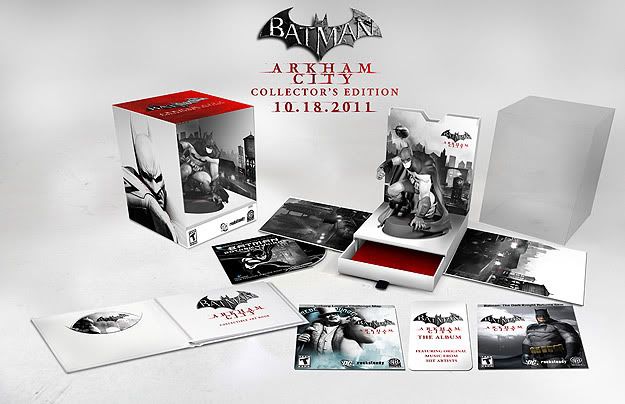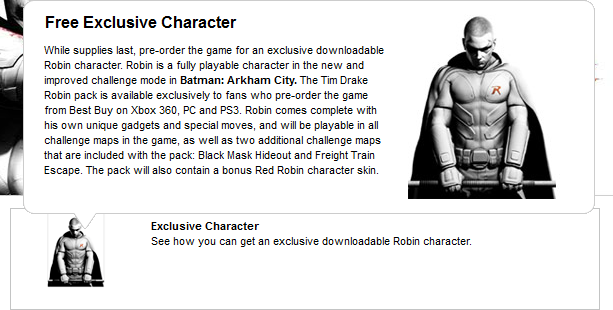You are using an out of date browser. It may not display this or other websites correctly.
You should upgrade or use an alternative browser.
You should upgrade or use an alternative browser.
Arkham Has Moved
- Thread starter Max Payne
- Start date
Rumpelstiltskin
Banned
- AKA
- L, Castiel, Scotty Mc Dickerson
My kingdom for a nightwing!
X-SOLDIER
Harbinger O Great Justice
- AKA
- X
Apparently the Netherlands can get this pre-order from Gamemania.be. Other regions still pending. I'm hoping that all of these get into a proper DLC package for those who pre-ordered elsewhere.
Despite the Cole/Starkiller/Eminem/etc comments running rampant, I have to say that I dig this look. It'll be nice to see how he looks and moves in game. I'm curious now, with Robin getting an additional skin, I wonder if they'll decide to release alternate skins for Batman & Catwoman as well.
SarahMay, the community team lady for the Arkham City Forums says that, "He feels and moves like I imagined Tim Drake Robin would when I read the comic."
X
Despite the Cole/Starkiller/Eminem/etc comments running rampant, I have to say that I dig this look. It'll be nice to see how he looks and moves in game. I'm curious now, with Robin getting an additional skin, I wonder if they'll decide to release alternate skins for Batman & Catwoman as well.
SarahMay, the community team lady for the Arkham City Forums says that, "He feels and moves like I imagined Tim Drake Robin would when I read the comic."
X

Cookie Monster
NOM NOM NOM
Arkham City Box Art:

It's the same for the 360 and PC.

It's the same for the 360 and PC.
Cookie Monster
NOM NOM NOM
"We wanted to create a Robin that players would identify as a contemporary character and move away from the traditional "Boy Wonder" image that most people know. Our vision of Robin is the one of a troubled young individual that is calm and introverted at times but very dangerous and aggressive if provoked. The shaved head is inspired by cage fighters, because we thought that Robin might be doing that in his spare time to keep him on his toes. Still, we kept all the classic trademarks of Robin's appearance, such as the red and yellow colors of his outfit, the cape and the mask.
We really hope that people will discover our Robin as one of their new favorite characters in the Batman universe. He is back and he means business."
Sauce
Also, latest concept art:

X-SOLDIER
Harbinger O Great Justice
- AKA
- X
Looks like they're releasing Concept Art if fans manage to solve the riddle in the video by Friday.
X
If you pause throughout the video, there are split second sections that show words with numbers inside them:
Ridd(9)le m(1)e t(13)his wh(2)at doe(5)s i(20)t t(20)ake t(5)o kee(18)p a(20) Shar(8)p pup(1)pet o(14)n (25)a Str(15)ange str(21)ing?
So, you get the main phrase:
"Riddle me this- What does it take to keep a Sharp puppet on a Strange string?"
And the numbers inside correspond to the sentence:
"I am better than you."
There's a TON more effort looking into it in a REALLY huge page on the Arkham City Community Forums.
Ridd(9)le m(1)e t(13)his wh(2)at doe(5)s i(20)t t(20)ake t(5)o kee(18)p a(20) Shar(8)p pup(1)pet o(14)n (25)a Str(15)ange str(21)ing?
So, you get the main phrase:
"Riddle me this- What does it take to keep a Sharp puppet on a Strange string?"
And the numbers inside correspond to the sentence:
"I am better than you."
There's a TON more effort looking into it in a REALLY huge page on the Arkham City Community Forums.
X

X-SOLDIER
Harbinger O Great Justice
- AKA
- X
http://www.comicsalliance.com/2011/07/14/batman-arkham-city-two-face/
(Click for large version)

X
(Click for large version)

TWO-FACE
Real Name: Harvey Dent
Occupation: Professional Criminal
Base: Gotham City
Eyes: Blue
Hair: Brown/Grey
Height: 6 ft
Weight: 182 lb
First Appearance: Detective Comics #66 (August 1942)
Attribute 01: Hideously scarred on the left half of his face, which he plays up with clothing that's differently styled on one side
Attribute 02: Extremely skilled with his weapons of choice: twin .45 automatics
Attribute 03: Psychotic obsession with duality, designing crimes around the number two
Attribute 04: Defers to his half-scarred coin in choices of life or death
Info_01_Name: TWO-FACE
Story: District Attorney Harvey Dent was one of Batman's strongest allies in Gotham City, until a criminal threw acid in Dent's face, hideously scarring him. The wounds fractured his psyche, and he was reborn Two-Face, a schizoid criminal mastermind obsessed with duality. His former good-luck charm, a "two-headed" trick silver dollar, was damaged on one side in the attack, and Dent has seized on it as a reflection of his half-scarred visage. He flips it to decide the fates of his victims. Two-Face is thriving in Arkham City, rallying inmates to join his gang using tried and true campaign tactics.
X

X-SOLDIER
Harbinger O Great Justice
- AKA
- X


The Batman: Arkham City Collector’s Edition will be available in limited quantities for $99 beginning Oct. 18, 2011 in North America for the PlayStation 3, Xbox 360 and PC, and it will include the following extensive bonus content:
• Custom Batman statue produced by Kotobukiya
• Collectible art book
• Early access to the Iceberg Lounge Challenge Map and Batman: The Dark Knight Returns skin
• Batman: Arkham City album from WaterTower Music including original songs by hit artists, available via digital redemption
• Bonus DC Universe animated original movie, Batman: Gotham Knight
• Four collectible cards
I'm thinking that pre-ordering from BestBuy is the way I'm gonna have to go with this. I wonder if I'll have time today...
X

Sheva Alomar
I'm Alive and on Fire
- AKA
- Adri, Sir Integra, Fiona, Sango
This should be the standard for Collector's Editions.
Also, fuck Best Buy's Robin bribe. I will continue to pre-order with GameStop.
Also, fuck Best Buy's Robin bribe. I will continue to pre-order with GameStop.
X-SOLDIER
Harbinger O Great Justice
- AKA
- X
http://www.joystiq.com/2011/07/21/batman-voice-actor-says-arkham-city-will-have-future-episodes/
X
Professional Batman voice provider Kevin Conroy recently spoke to Comic Booked about his illustrious past and apparently infinite future with the franchise. On the subject of Rocksteady's upcoming Dark Knight simulator, Batman: Arkham City, Conroy shared some promising news: "The thing about Arkham City is that it's going to be an ongoing game," Conroy explained. "You're going to be able to download future episodes of it, so it's going to be going on for quite a while. I've been recording it for a while."
This news is noteworthy for two reasons: First, we're big proponents of having access to Batman unending, so the prospect of downloadable post-launch "episodes" is attractive, provided we're talking about full-on Gotham adventures and not just challenge rooms. Second, if Conroy's been recording Arkham City vocals for "a while," he must have vocal chords crafted from raw adamantium. Seriously, have you ever tried doing a Batman impression? Have you ever tried doing it every day for two decades?
X

Gym Leader Devil
True Master of the Dark-type (suck it Piers)
- AKA
- So many names
Annnnnnd Dacon makes my whole day with seven words. Grundy needs more love.
Max Payne
Banned
- AKA
- Leon S. Kennedy,Terry Bogard, The Dark Knight, Dacon, John Marston, Teal'c
http://uk.ps3.ign.com/articles/118/1183325p1.html

WTF Talia is supposed to look middle eastern, not, whatever the hell this is.

WTF Talia is supposed to look middle eastern, not, whatever the hell this is.
Sheva Alomar
I'm Alive and on Fire
- AKA
- Adri, Sir Integra, Fiona, Sango
Reject Buffy.
X-SOLDIER
Harbinger O Great Justice
- AKA
- X
Interesting interview with Paul Dini.
X
Batman: Arkham City's creators and voice actors steadfastly refused to give out any new information about the game at last weekend's Comic-Con panel, instead just showing a new Penguin trailer. But both Paul Crocker, the lead narrative designer at Rocksteady Studios, and the legendary Paul Dini, Batman writer extraordinaire, kindly sat down to speak with Joystiq beforehand about the story of both Batman: Arkham Asylum and the upcoming sequel.
Arkham Asylum's story was mainly about the Joker's takeover of Arkham and how Batman dealt with it, but those who explored the sidequests and secrets of the game got a look at the overarching plot of the series, that of Warden Quincy Sharp and his mysterious ties to Arkham itself.
That story is what drives the sequel forward, and Crocker says that it actually appeared right in the middle of the two games' development: The secrets in the first game were "a late addition," put in while development on the sequel was alrady underway. "The biggest challenge for us was taking the game out of Arkham Island and into Arkham City," he says. "As people have seen in the secret room in the last game, we had it planned. I guess it was a rough road back, to a degree, because that meant we had to do it. But the idea of the city has grown into bigger and bigger detail, and really that was the biggest challenge."
Dini says he was first impressed by the work Rocksteady is and was doing, not when he saw any character designs or gameplay, but just simply when he viewed the concept art for the first time. "It had a very English look to it, it was things like 'Arkham Asylum' put on a brass plate on a brick wall with ivy twisted around it," he remembers. "They just got it. They knew what it was supposed to be and how it was supposed to look. The juxtaposition of the very modern Batman gadgets, and yet something that almost looks Victorian."
He's also been focusing on Quincy Sharp lately, releasing an Arkham City comic book with DC that tells the story of how now-Mayor Sharp has convinced Gotham City to lock off an entire section for Arkham inmates (which players, of course, will get to explore as Batman in the new game). "We wanted to have a big event that would sort of play into people's paranoia and fear that Sharp would use to say 'this disaster has happened, let's lockdown the city,'" says Dini. Warner Bros. briefly considered actually making an animated film about the in-between period, but eventually "a comic book seemed to have the immediacy that we needed to set up the story."
Dini also shared some insight on the various members of Batman's villains' gallery that have shown up in the game. The Mad Hatter, for instance, almost showed up in Arkham Asylum. "Mad Hatter we went back and forth about," Dini says. "We thought that Arkham Island, if it was an old family estate, should have a maze and hedges and an area for children, and whatever that had rotten into in the present day would be where the Mad Hatter would be. To have sort of like an English garden party feel, and so we experimented with that."
Crocker says that the second game will line up new stories for some of the characters seen in the first game as well. "We take some of the cameos in the first game to actually finding or meeting that character," he hints.
Dini adds that even Sharp, with as big a role as he plays, isn't the end of the storyline that detective Batman has to uncover. "You see that he's being manipulated from behind by Hugo Strange, who's also manipulating some of the villains as well, even though they're largely unaware of it."
Finally, it was perhaps most exciting to hear that, outside of any new story information, Dini wants to make sure that the gritty realism and real danger continues to back up the goofy fun of Batman's universe in the second game. "I feel like it almost goes back to the stories for kids, fairy tales," he says. "It can be whimsical, you can have talking birds and animals and monsters but if the threat isn't real, if the ogre isn't going to kill the hero or the dragon isn't deadly, the rest of the story isn't going to work. It's like the whimsy compels the story along until you get to that moment, to the big finale.
"And I've always felt that Batman's world is sort of similar to that," Dini continues. "You can have villains like the Penguin, who strut around in a tuxedo with an umbrella and Poison Ivy and all of the fantastic stuff she does, but unless there's a bit of a human in there, and unless there's a credible threat, then Batman himself doesn't work."
X

X-SOLDIER
Harbinger O Great Justice
- AKA
- X
http://gotgame.com/2011/07/27/exclusive-arkham-city-joker-tape-revealed/
Penguin Audio Tape
Joker Audio Tape
X
Penguin Audio Tape
Joker Audio Tape
X

Max Payne
Banned
- AKA
- Leon S. Kennedy,Terry Bogard, The Dark Knight, Dacon, John Marston, Teal'c



